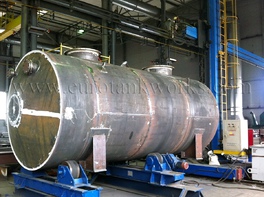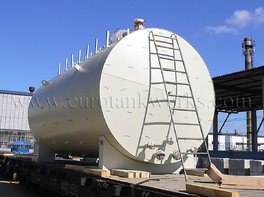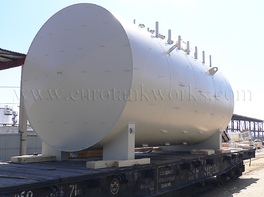Technological Process of Horizontal Tanks Fabrication
- Initial check (incoming test);
- Metal preparation;
- Manufacturing of the wall;
- Manufacturing of the endwalls, manway plates and pipe junctions;
- Backing holders and maintenance shaft production;
- Tank assembling;
- Corrosion preventive procedures
To ensure the effective use of the horizontal tank, the pre-production stage demands special attention to the choice of steel type. As a rule, steel of st3sp, 09G2S is used in our production, along with stainless steel types AISI304 and AISI321 of 4 to 10 mm thickness.
The tank wall is a set of several shells, made of roll or steel plate (1500 mm wide).The firmness of the framework is provided by the supportive (with triangle diaphragm plate) and midpoint (interim) stiffening-rings. The rigidity of the tank wall in the course of transportation, re-load and installation is ensured by the horizontal stiffening-rings made of standard section and toe-welded to the wall. Such scheme provides the rigidity of walls, exposed to vacuum and wind influence.
The bottom of the horizontal tank is flat, manufactured with the excessive pressure up to 40 kPa. The pressure level from 40 kPa to 70 kPa requires the conical shaped bottoms. To ensure the framework firmness flat bottoms are often reinforced by the stiffening plates.
The framework of the ground-level horizontal tanks includes two supporting structures: saddle shaped or poles. The angle of contact of the saddle-shaped structure is 60-120°.
The framework of underground horizontal tanks is provided with the maintenance shafts, enabling the access of the staff to the tank dome and technological pipelines.

















